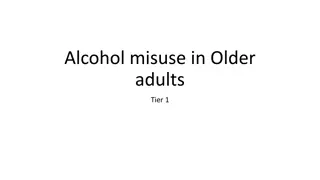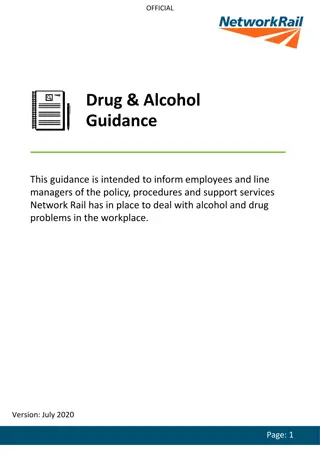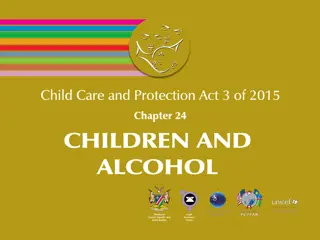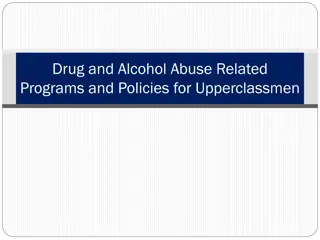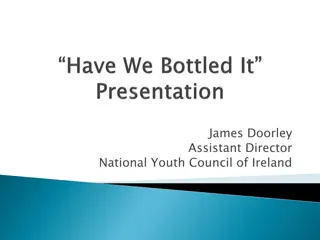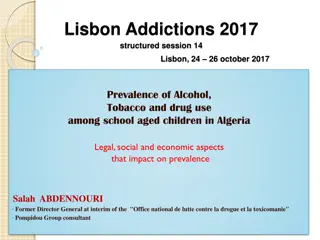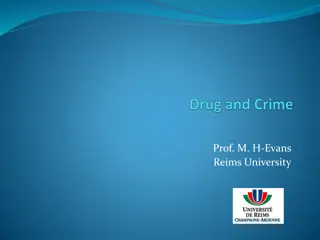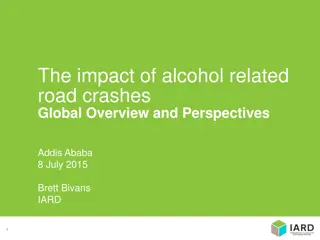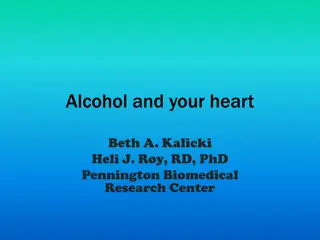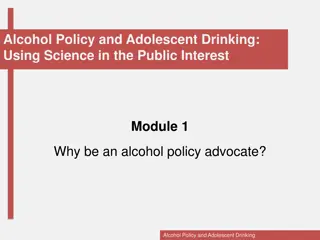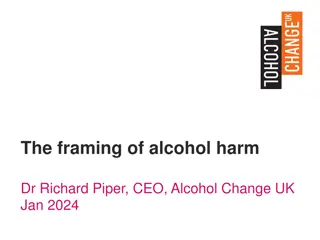Alcohol Misuse in New Mexico: Prevalence and Risk Factors
Alcohol consumption, heavy drinking, and alcohol use disorder prevalence in New Mexico are significant issues. Risk factors for heavy drinking include gender, age, marital status, employment, income level, education, family history of alcoholism, and mental health conditions.
Download Presentation

Please find below an Image/Link to download the presentation.
The content on the website is provided AS IS for your information and personal use only. It may not be sold, licensed, or shared on other websites without obtaining consent from the author.If you encounter any issues during the download, it is possible that the publisher has removed the file from their server.
You are allowed to download the files provided on this website for personal or commercial use, subject to the condition that they are used lawfully. All files are the property of their respective owners.
The content on the website is provided AS IS for your information and personal use only. It may not be sold, licensed, or shared on other websites without obtaining consent from the author.
E N D
Presentation Transcript
Alcohol Misuse in New Mexico Prevalence of Heavy Drinking and Alcohol Liver Disease Tim Werwath, Coop Consulting, Inc.
Overview Alcohol consumption is high in the United States, but far below other countries such as Australia and France. o Many countries with higher consumption have a lower prevalence of alcohol use disorder. 14.8 million Americans 18 and older have an alcohol use disorder (6.1%) 155,000 New Mexicans 18 and older have an alcohol use disorder (7.4%) Sources: World Health Organization; 2015-2016 National Survey of Drug Use and Health
Definitions Alcohol use disorder (AUD) is characterized by: o Increased tolerance o Withdrawal symptoms o Continued use despite problems o Inability to fulfill roles o Neglect of activities o Increased time spent drinking o Inability to cut down Patterns of drinking at high risk for developing an AUD: Binge drinking Drinking that brings BAC to levels above 0.08 - typically 5 or more drinks for men, 4 or more drink for women Heavy drinking Drinking more than 3 drinks on a single day or 7 drinks per week for women, 4 drinks on a single day or 14 drinks per week for men Source: National Institute on Alcohol Abuse and Alcoholism
Risk Factors for Heavy Drinking Men have higher rates than women (6.3% vs. 5.5%) Rates are highest among those 18-24 (6.7%) o Steadily decline with age and dramatically decline after age 64 People who are married have lower rates o 5.4% vs. 7.3% for those never married and 5.7% for those divorced Source: Center for Disease Control and Prevention, 2016 Behavioral Risk Factor Surveillance System
Risk Factors for Heavy Drinking People who are employed have higher rates o 7.0% vs. 5.6% for those unemployed and 3.3% for those unable to work Rates are highest among those making $75,000 or more o Steadily decline with lower levels of income People with a college degree have higher rates o 6.1% vs. 4.9% for those without a high school degree Source: Center for Disease Control and Prevention, 2016 Behavioral Risk Factor Surveillance System
Risk Factors for Heavy Drinking Family history of alcoholism especially if paired with childhood family violence and parental antisocial behavior Anxiety and/or depression especially among those with a coping style of avoidance rather than confrontation Explicit attitudes towards alcohol (i.e., drinking to blow off steam )
Prevalence of Heavy Drinking in NM Rates of heavy drinking rose in the early 2000s but then declined and have been relatively constant since 2005 Rates are higher in New Mexico among: o Individuals 25-44 (compared to 18-24 nationally) o American Indian and Hispanic males o Black and White females
Prevalence of heavy drinking among adults 18 and older in New Mexico by age, race/ethnicity, and gender, 2014-2016 Source: New Mexico Department of Health, Epidemiology and Response Division
Prevalence of heavy drinking among adults 18 and older in New Mexico by county, 2014-2016 Source: New Mexico Department of Health, Epidemiology and Response Division
Consequences of Heavy Drinking The leading cause of death from excessive alcohol use is alcoholic liver disease The greater the amount and longer the duration of heavy drinking, the more likely the disease will develop On average, having six or more drinks per day will lead to cirrhosis of the liver in 10 years for men and 5 years for women1 o The amount of alcohol that leads to liver damage is extremely variable from person to person 1American College of Gastroenterology, Alcoholic Liver Disease: A Consumer Health Guide
Alcoholic Liver Disease (ALD) Fat accumulation in liver cells from the metabolism of alcohol The replacement of normal liver tissue by scar tissue due to repeated injury Inflammation of the liver, a reaction to fatty deposits in liver cells
Risk Factors for ALD Women are at a greater risk for ALD at lower quantities of alcohol than men, even accounting for body size Genetic factors influencing the production of liver enzymes involved in metabolism Drinking outside of meal times increases the risk of ALD by nearly three times Source: Mayo Clinic, Pathogenesis, Diagnosis, and Treatment of Alcoholic Liver Disease
Diagnosis of ALD In the early stages, ALD exhibits subtle and often no abnormal physical findings Symptoms of advanced ALD include yellowing of the skin and eyes (jaundice), altered consciousness, and increased belly size due to fluid accumulation The progression of ALD to liver cirrhosis is mostly irreversible - liver transplantation is the only definitive treatment option Source: Mayo Clinic, Pathogenesis, Diagnosis, and Treatment of Alcoholic Liver Disease
Deaths from ALD are Increasing Nationwide, ALD is the 12th leading cause of death (37,890 deaths in 2013) The death rate from ALD increased by 18.6% between 2000 and 2013 Rates increased the most for white males (19%) and females (50%), and individuals aged 25-34 (55%) Source: Yoon, Y. H., C. M. Chen, and H. Y. Yi. "Liver cirrhosis mortality in the United States: National, State, and Regional Trends, 2000-2013." NIAAA Surveillance Report #105, 2016
Deaths from ALD are Increasing All Alcohol-Related Deaths Per 100,000 Population, New Mexico and the United States 70.0 65.7 66.0 60.0 59.4 53.554.4 54.0 53.5 53.0 50.6 50.0 50.5 50.549.4 49.2 48.6 48.647.7 47.9 47.1 46.6 46.2 46.4 45.7 44.245.2 44.2 44.5 45.1 40.0 32.2 30.930.229.3 29.4 29.2 28.728.027.3 26.926.1 26.1 26.6 27.2 27.4 27.4 27.8 28.1 28.3 28.2 27.6 27.9 28.5 30.0 29.430.1 26.0 20.0 10.0 0.0 1990 1991 1992 1993 1994 1995 1996 1997 1998 1999 2000 2001 2002 2003 2004 2005 2006 2007 2008 2009 2010 2011 2012 2013 2014 2015 2016 New Mexico United States Source: New Mexico Department of Health, Epidemiology and Response Division
Deaths from ALD are Increasing Alcohol-Related Deaths Per 100,000 Population, New Mexico, by Type 40.0 35.0 30.0 25.0 20.0 15.0 10.0 5.0 0.0 1998 1990 1991 1992 1993 1994 1995 1996 1997 1999 2000 2001 2002 2003 2004 2005 2006 2007 2008 2009 2010 2011 2012 2013 2014 2015 2016 Chronic Disease Injury Source: New Mexico Department of Health, Epidemiology and Response Division
Prevalence of ALD death in New Mexico ALD accounts for about a quarter of all alcohol-related causes of death in New Mexico Rates of ALD death are nearly twice as high among men compared to women (25.5 per 100,000 compared to 13.3) Rates of ALD death are highest among Native American and Hispanic males, and Native American females
Prevalence of alcohol-related chronic liver disease deaths in New Mexico by county, 2012-2016 Source: New Mexico Department of Health, Epidemiology and Response Division
Thank you! Tim Werwath Coop Consulting, Inc. coopconsulting.nm@gmail.com




